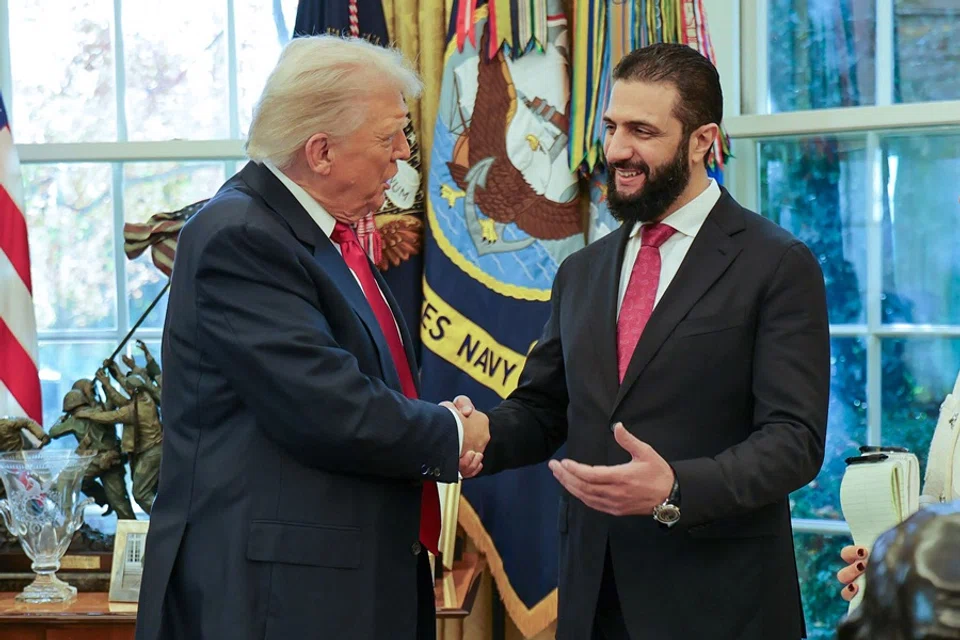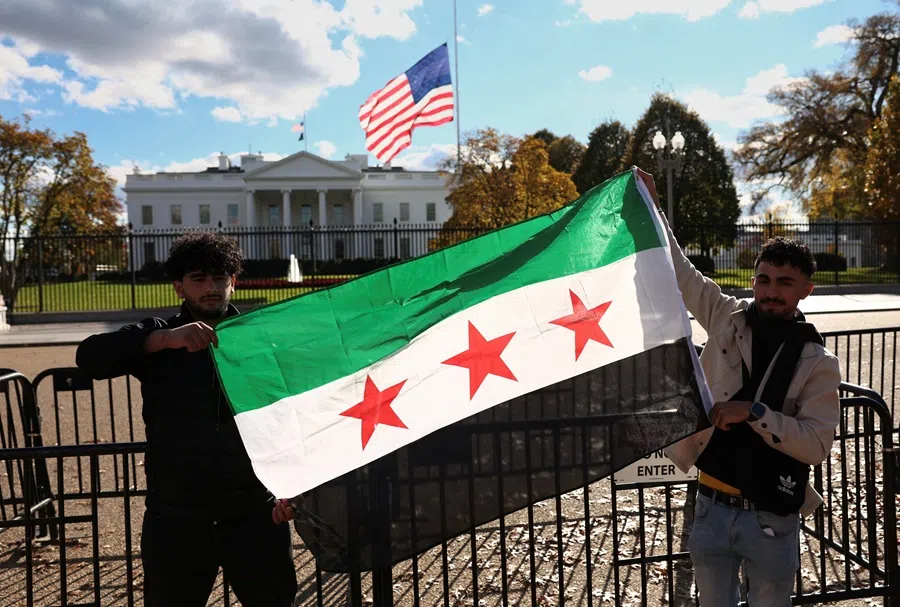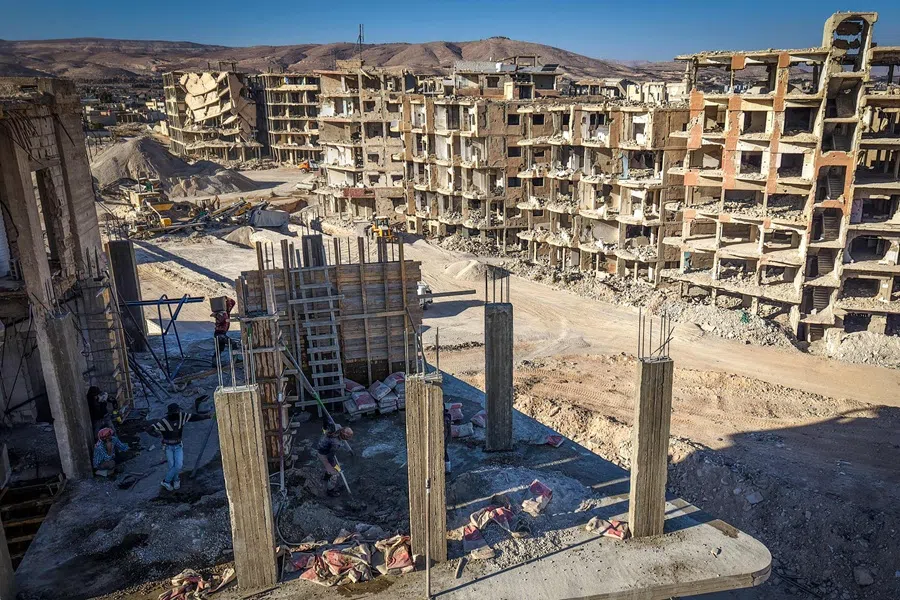America’s new partner in Damascus — and China’s strategic setback
The restoration of US–Syria relations proves to be an obstacle for China’s influence in the eastern Mediterranean, as the new Syrian government is less receptive to China. Academic Ma Haiyun says that for China, the loss of Assad and the unresolved Uighur presence in Syria reveal the limits of its Middle Eastern diplomacy.

The restoration of US–Syria relations after the civil war owes much to the activism of the Syrian diaspora that fled Bashar al-Assad’s dictatorship in the 1990s and resettled in Washington and New York. Among them, two figures stand out: Mouaz Moustafa, founder of the Syrian Emergency Task Force (SEFT), and Rabbi Yosef Hamra, spiritual leader of the Syrian-Jewish community in Brooklyn.
“If you want a stable and safe Syria… even if it’s as simple as rebuilding the oldest synagogue in the world, the only person able to make that a reality today is, frankly, Donald Trump.” — Mouaz Moustafa, Founder, Syrian Emergency Task Force
Uniting Syrians: from Damascus to Washington
Moustafa’s SETF evolved from a humanitarian relief organisation into a policy and advocacy platform, connecting Syrian diaspora networks with US foreign-policy circles — especially after the fall of the Assad regime in late 2024.
The regime collapsed under the Syrian nationalist movement led by Ahmad al-Sharaa (also known as Abu Mohammad al-Jolani). Al-Sharaa’s rebranding of his group — from Jabhat al-Nusra to Jabhat Fatah al-Sham, and finally to Hay’at Tahrir al-Sham (HTS) — signalled his shift away from global al-Qaeda jihadism towards Syrian nationalism, culminating in the overthrow of the Assad dynasty.
The success of al-Sharaa’s movement reignited hopes among Syrian Americans — Muslim and Jewish alike — to rebuild ties with Washington and to restore relations with America. Immediately after Assad’s fall, SETF and Hamra’s community jointly lobbied the White House to lift US sanctions, particularly the Caesar Act — targeting Assad and his regime for war crimes against the Syrian people — to enable post-war reconstruction and the restoration of Syria’s ancient Jewish heritage.
In February 2025, SETF organised a delegation of Syrian-American Jews led by Hamra to visit Damascus. As Moustafa remarked, “If you want a stable and safe Syria… even if it’s as simple as rebuilding the oldest synagogue in the world, the only person able to make that a reality today is, frankly, Donald Trump.”

Three months later, on 14 May 2025, US President Donald Trump met al-Sharaa in Riyadh, followed by a second encounter on the sidelines of the United Nations (UN) General Assembly in September. In early November, Washington requested that the UN Security Council lift sanctions on Syria’s new leadership; two days later, the security council approved the motion with 14 votes in favour and one abstention — a remarkable reversal of global policy.
Russia voted in favour, citing the resolution as “reflective of the Syrian people’s aspirations”, while China abstained, citing unresolved concerns over “foreign terrorist fighters, including members of the East Turkestan Islamic Movement”.
In effect, the US replaced Assad’s Iran- and Russia-backed regime with a government more aligned with Western and Arab partners.
Al-Sharaa: Washington’s new partner
Al-Sharaa’s 10 November 2025 visit to the White House — the first by a Syrian head of state since 1946 — signalled a new era. The US announced a partial suspension of the Caesar Act, which had targeted Syria’s energy industry and deterred foreign investment. The exemptions, however, explicitly excluded transactions involving Russia and Iran, including the transfer of their goods, technology or financial services.
Although the full details remain undisclosed, reports suggest agreements on Syria’s participation in the US-led coalition against ISIS, the reopening of the Syrian Embassy in Washington, and discussions on integrating the Kurdish-led Syrian Democratic Forces into the national army and the security relations with Israel. Trump hinted that “an announcement on Syria” would follow.

For Washington, embracing al-Sharaa serves both symbolic and strategic purposes. Domestically, it reinforces Trump’s image as a peacemaker; strategically, it anchors Syria within a Sunni-Western security framework spanning Israel, Egypt and the Gulf monarchies. In effect, the US replaced Assad’s Iran- and Russia-backed regime with a government more aligned with Western and Arab partners.
Having lost a predictable partner in Assad, Beijing now faces a strategic paradox: a US-aligned Damascus that hosts groups China classifies as terrorists.
Losing Assad, Beijing’s old friend
For two decades, China stood firmly behind Assad, defending Damascus at the UN and promoting post-war reconstruction through the Belt and Road Initiative. The partnership peaked in 2023, when Assad visited Hangzhou and met Chinese President Xi Jinping, sealing a Sino-Syrian strategic partnership — Beijing’s highest diplomatic recognition since the two countries established relations in 1956.
That foundation has since collapsed. Assad now lives in exile, while al-Sharaa, recognised by Washington and Arab capitals, leads a government less receptive to Chinese influence. Beijing’s most acute dilemma lies in northern Syria, where thousands of Uighur militants once aligned with the Turkistan Islamic Party (TIP) remain entrenched. Roughly 15,000 Uighurs and their families are estimated to remain, with 3,500 integrated into the new Syrian army’s 84th Division.
Having lost a predictable partner in Assad, Beijing now faces a strategic paradox: a US-aligned Damascus that hosts groups China classifies as terrorists. While limited in scale, these Uighur enclaves complicate China’s regional diplomacy and could be exploited by Western actors to constrain Beijing’s influence in the eastern Mediterranean.

The reconfiguration of US policy under Trump — ending direct counterterrorism operations while recasting Damascus as a regional security partner — has further marginalised China’s counterterrorism narrative. As in Afghanistan, Beijing remains constrained: it cannot demand deportation of Uighur fighters, yet cannot ignore their long-term risks. A pragmatic path forward would link Chinese reconstruction aid to Syria’s peace-building process, enabling quiet cooperation with regional stakeholders and promoting multilateral management of the Uighur question.
For the US, partnership with al-Sharaa strengthens an emerging regional architecture linking Israel, Turkey, Egypt and the Gulf states, further marginalising the Palestinian issue.
Making Syria peaceful — and relevant — again
Post-Assad Syria embodies a transformed geopolitical order. Al-Sharaa’s pragmatic nationalism has replaced Assad’s isolationism, positioning Damascus as a pivotal actor amid the US–Russia–Iran rivalry. Whether Syria consolidates as a pillar of a Sunni-Western alliance or as a mediating bridge among competing blocs will define its future role.
For the US, partnership with al-Sharaa strengthens an emerging regional architecture linking Israel, Turkey, Egypt and the Gulf states, further marginalising the Palestinian issue. For China, the loss of Assad and the unresolved Uighur presence in Syria reveal the limits of its Middle Eastern diplomacy.
Ironically, the Uighur issue — long seen as a liability — may offer a modest avenue for cooperation. A policy of gradual demobilisation and localised integration, supported by Chinese reconstruction funding and Syrian oversight, could stabilise Syria and ease China’s anxieties. If managed prudently, Damascus might convert a domestic security challenge into diplomatic capital — restoring internal peace, accommodating China’s concerns, and tempering US–China rivalry in the Levant.





